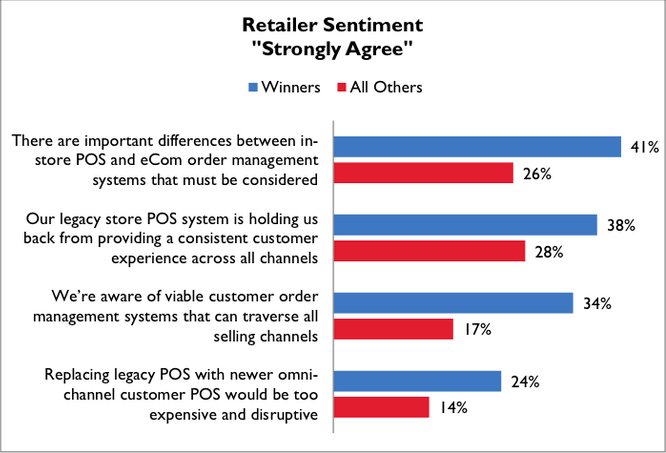We are witnessing big changes. Following the events of the last decade on the eCommerce market and putting it together with the current situation in traditional commerce, it is difficult not to resist of impression that big changes are coming.
The market of shopping centres in Poland will soon reach the boundaries of dynamic growth. In 2015 the first noticeable decline in the so-called footfall appeared, which means that particular stores are visited by a smaller number of potential customers. Such situation enforced, in some cases, changing the strategy and renegotiating some of the lease contracts. And this is only the beginning.
An online store that supports traditional sales is a standard for each sales chain
In the chains that thought about it well in advance we can see that as standard about 5% of the whole turnover of the store is generated by an online store. There are also companies that from the very beginning treat the Internet as the main source of their activities and now have the results of 10% to even 20% of turnover online.
It often happens that a single online store may generate the turnover of a few good brick and mortar stores, with less expense. This results in resignations from some of less profitable points, which can in turn result in vacant places in shopping centres that have to be managed somehow. The so-called pop-up stores may turn out to be the hope for such places; these are the stores that appear in a given area for promotional purposes, for a specified time, and then disappear. This strategy is particular favourable to online stores. A well-established image, among customers, may hold their attention and arise their interest in the offer of an online store. We could observe such strategy in Złote Tarasy in Warsaw where Zalando presented its pop-up store. The opening of a temporary store was preceded by a series of events like giving Blogger Award awards and a series of DIY workshops.
The best results may be expected by the companies which backs sustainable development consistent with the OmniChannel strategy
A well-managed online store additionally drives traffic in brick and mortar stores, among other things by free collection points, the possibility of checking the stock levels, reservations, returns, claims etc. The example may be the Polish project Answear.com which intensified the opening of an online store in 2011 by opening two brick and mortar stores in Kielce and Poznań, offering a part of the functionalities mentioned.
And here another challenge appears: how to settle with the ingoing customers that come to sales chains only to collect the product bought earlier at the online store. This is the situation in which the store is forced to pay double for the customer. The first time at the online store. The second time, when it has to pay the owner of the shopping centre for the fact that the customer has come to collect the parcel bought, thus increasing the footfall and turnover of the store on which the rent is calculated. There are several ways to solve this problem and in each of them the software may play the key role.
More and more actively the companies of the so-called pure internet join the game for the offline customer
These are the companies that grew based on the technology, they have been keeping online stores for a long time and more and more often they think about not the single point of sale but about the whole chain, thus fulfilling the OmniChannel strategy.
Only now in Poland we can observe the single examples of opening brick and mortar stores by companies which are typically online in their nature, and such trend will be more and more stronger over time. Their unquestionable advantage is that they usually already have a well-developed system in which they are constantly investing and know its possibilities. For them, adding subsequent functionalities and increasing the number of free collection points, having selected a well-organised team of specialists, may take little time. These are, despite everything, the companies that we heard relatively not much of in Poland but their capital and trend towards OmniChannel customer, that are constantly growing, rouse appetite for investment in physical points of sale.
The example of such kind of actions may be the Chinese giant Alibaba who in 2014 bought, after years of dynamic expansion in a global chain, the block of 220.5 mln shares of Intime Retail Group (IRG; the owner of department stores and superstores) for approx. USD 219 mln. In 2015 it bought 19.99% of shares of Suning – one of the biggest chain of stores with electronic equipment in the country (for approx. EUR 4.15 mln). This is a simple way for natural competitors to establish cooperation, which will after all be advantageous for both companies. Suning will get the opportunity of starting online sales fast, among other things by creating an online store, on Alibaba website, designed for commercial partners – Tmall. Alibaba, however, will be able to use Suning infrastructure to store and deliver the goods sold at the platform in OmniChannel model.
CCC brand applied a similar strategy. One of the biggest chain of stores with shoes bought 75% of shares of Eobuwie.pl – a company from Zielona Góra. Although the average shopping basket in both cases differ significantly, both entities gained a natural complement to their offers. Eobuwie may offer brick and mortar free collection points, which in turn, as a natural consequence, will increase traffic in CCC stores and may translate into increased sales.
Online and offline commercial companies are looking more and more intensely for the possibility to get through to the end customer, from different places, thus diversifying the sales and fulfilling the OmniChannel strategy
This may take place in the form of acquisition, merger, like in the case of Alibaba and CCC, or the attempt to create one’s own dedicated solutions, like Answear.com did. We should, however, bear in mind that such programming-related solutions does not come into existence immediately. The era of fast and easy entry into online sales has come to an end. A good system of sale that implements the strategy of sales chain and meets the requirements of OmniChannel customers needs a few months and time for tests and stabilisation. Before the actual works can start, one has to draw up an analysis, deal with all legal matters and create system specification.
The changes in commerce are quicker and quicker. Postponing the key decisions on investment in OmniChannel even longer is disadvantageous and increases the costs of implementation and acquiring a potential customer via Internet.
 Polski
Polski  Deutsch
Deutsch 


